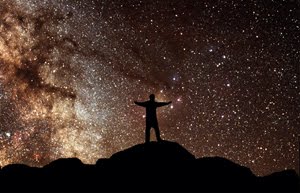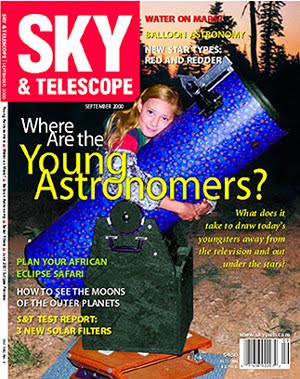I arrived at Coe just before 3 PM on Saturday to find the parking lot very full, likely spring fever sweeping the bay area and getting people outdoors. The western edge of the lot was lined with cars and trucks of people who were hiking into the park and spending the night. The center and eastern side of the lot mostly filled with day trippers. One hiker returned from hiking about 12 miles through the park. Rich Neuschaefer was there, and Richard Navarrete soon showed up. We sat and watched as people left, and their parking spots were replaced by amateur astronomers. The lot stayed full all day until sometime around midnight. Charlie Wicks and Michael Swartz each hauled out their Coronado solar equipment - and we enjoyed some excellent views of a very detailed surface, and large prominence off the lower limb. Imagine, getting a tan while doing astronomy!
Bob Havner was conducting the SJAA's Messier Marathon, and it seemed successful at getting some newcomers out observing - hard to get a real count, all the extra vehicles in the lot made it tough, but (based on the rather liberal use of headlights and interior car lights) I think there were around a dozen newcomers. Craig and Elana showed up with the behemoth D&G refractor. Daniel Stefanescu, Heather (?), Jim Collins, Mitch Roberts, Glen and Maria... I'm surely missing a few people - lots of observers.
The night began a bit breezy with heavy clouds to the west. During the evening you'd have to chase the open parts of the sky, but where it was clear, it was very good.
I had my 18" Obsession set up beside Richard, with his 18" Obsession. We both looking at targets in Canes Venatici, Coma Berenices and Hydra. Lots left in Virgo too, but the other constellations were in better position earlier. These are all the winter/spring constellations that contain a large number of Herschel targets, so, with the poor weather the past few years, it is difficult to get much time to chase them.
We actually started out looking at some shadow transits on Jupiter. Two, the trailing shadow clearly larger than the preceding one. Io and Ganymede. Kept looking for Io on the planet's disk, but not sure we really saw it. In moments of best seeing, it appeared Io might be intruding into the NEB (?) just slightly. Views of Saturn were also excellent last night.
Richard began poking around at bright Messiers, wherever there was some clearing, and I joined him. Some looked quite good... mainly the big open clusters. Then I began looking at planetary nebulae. The most stunning was easily the Eskimo Nebula, which under very steady seeing showed its central star - which contrasted well with the slightly brighter gold star just a few arc minutes to its north. Around the central star was a dark gap, a donut, and perhaps a few other shells. I had taken the magnification up to 293x, and decided to try the VHT filter Dan McShane at DGM Optics gave me: http://users.erols.com/dgmoptics/LPRfilters.htm . The contrast gain was remarkable. I did not compare it to an OIII or UHC, but I also had never seen the Eskimo with such clarity. The dark "donut" now jumped out, with a bright edge where it met the inner shell. That shell was bright and gave way to a dimmer, larger shell, which seemed to diffuse raggedly out into a third very tenuous shell. The color too was remarkable, clearly greenish-blue. Wish I had paid more attention to the color with the filter on - I was so interested in the structural detail that I didn't think about it. However, using this filter in the past, in particular up at Shingletown looking at the Veil Nebula, what was obvious about the filter was that it did not overwhelm the stars in the field - so you get the benefit of a good high quality, contrasty, nebula filter, and keep the stars too. I think looking at the Eskimo was the view of the night.
The NGC number I logged are: 5014, 5123, 5145, 5173, 5198, 5169, 5319, 5312, 5326, 5346, 5337, 5395, 5440, 4248.
I enjoyed NGC 5123 as it has additional bright (for me) galaxies on either side of it - just at the extremes of the field of view of my 20 Nagler - and interesting star fields - a small parallelogram of stars next to the target, and a "Hyades" shape near one of the other galaxies. Fun to hunt down.
Another fun field is NGC 5169, 5713 and 5198.... a nice easy star hop in a wide-field eyepiece from M51.
As for the dimmest of the night, I found NGC 5319, which NED lists surprisingly at mag 16.5, and The Sky at 15.5. Lots of averted vision and checking position. Very faint glow. I looked for NGC 5318A, which I think is MCG6-30-97, but, too dim. NGC 5312 was also in the field.
I enjoyed the view of NGC 5326, as it is in a distinctive chain of stars that are part of a very recognizable star field, with other galaxies in easy to locate positions. NGC 5346 was the most challenging of that view, coming in around the mid mag-14s.
It was nice to finish next to a bright Messier - M106 - on it neighbor NGC 4248. Fun to pop out some of the small galaxies near the big Messier.
Clouds moved in, and Rich, Richard and I pulled out chairs together, poured a few drinks, talked and joked about all the past Messier Marathons.
The best, I think was when we had a perfect night to observe, a big turnout, and Comet Hale-Bopp rose over the NE mountainside looking bright as a car headlight maybe around 2 a.m. Gorgeous.
The funniest was arriving at Coe having a snowball fight just before sunset - after which there was a party at my house.
We had a Messy-Marathon at Pacheco several years ago, when every Dob had water in it, the area was so wet.
After talking a bit, a cold wind came up... and that was it.... we all headed for our trucks, and called it a night.
Just nice to get out...











